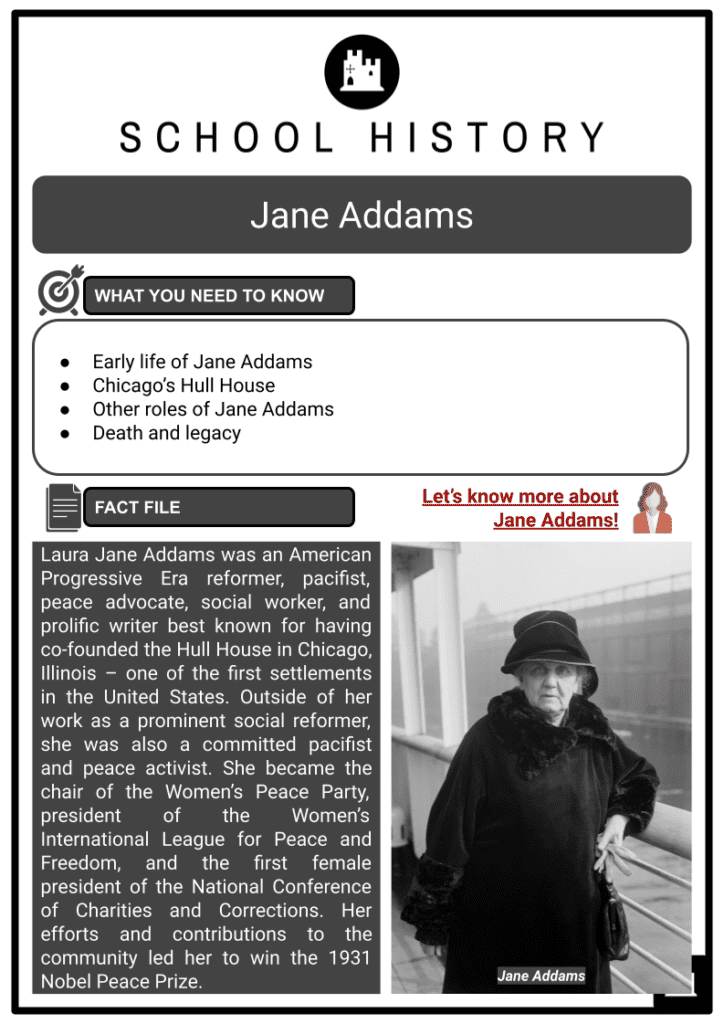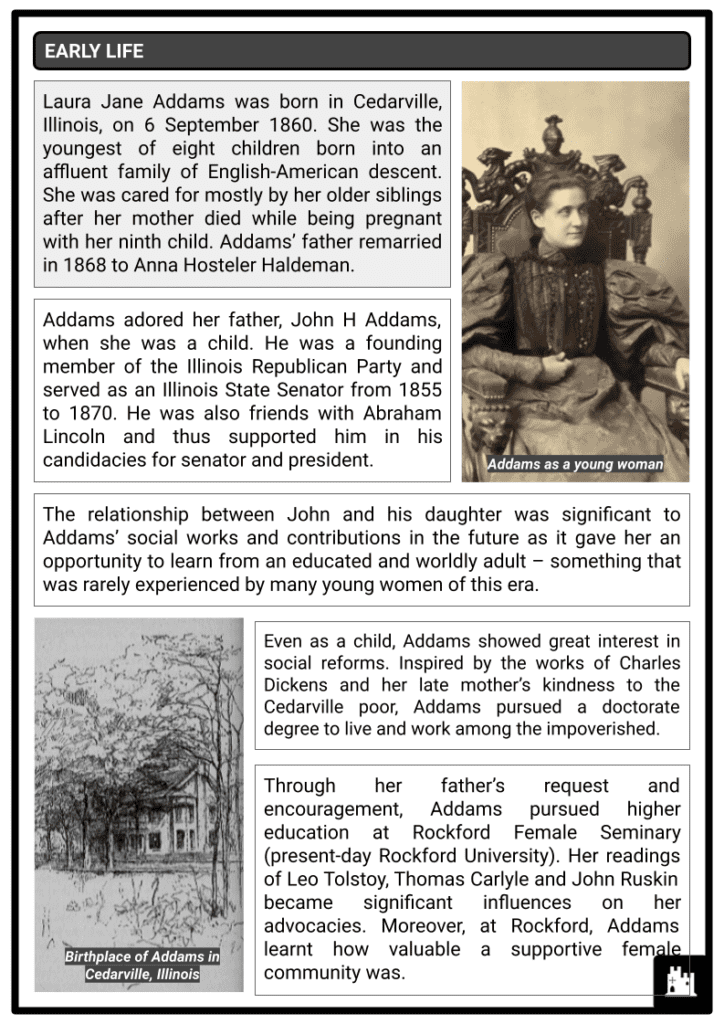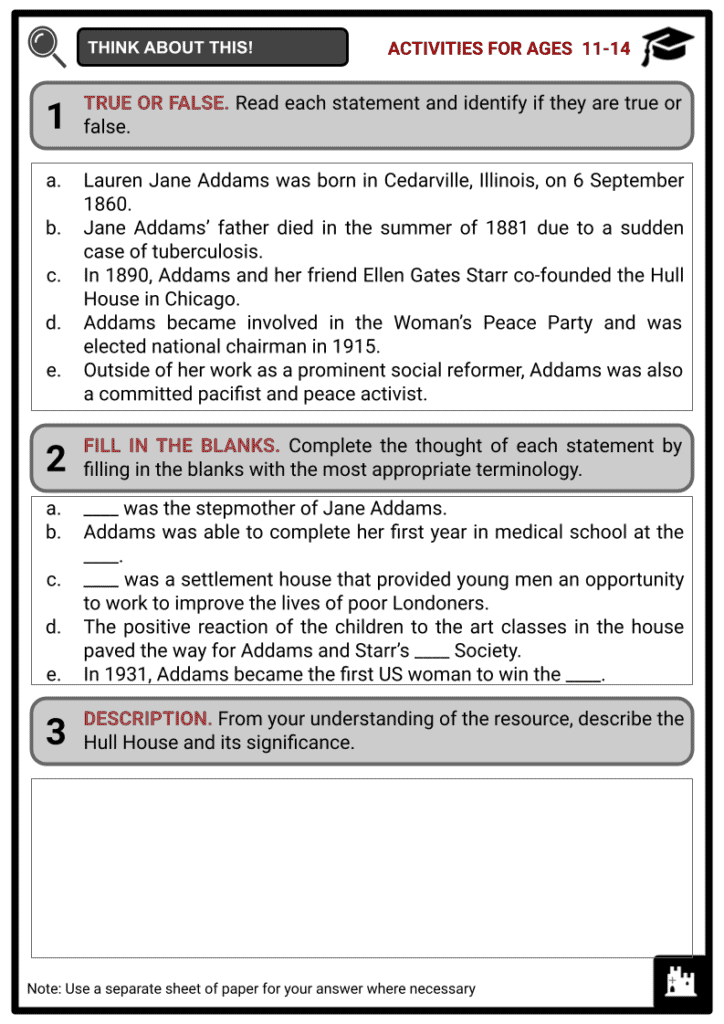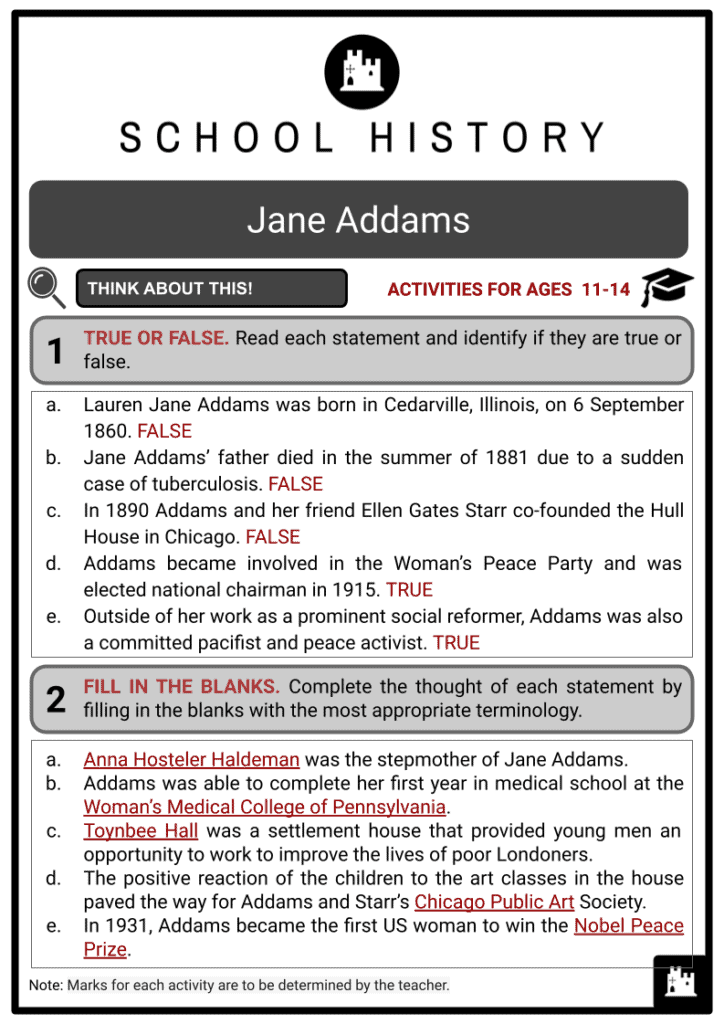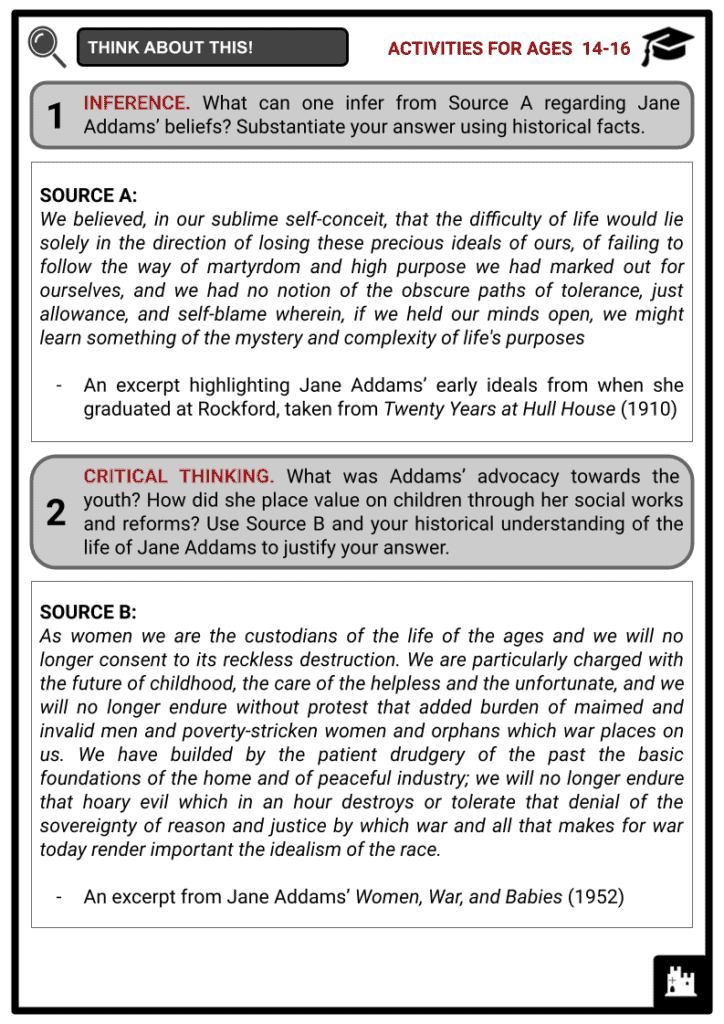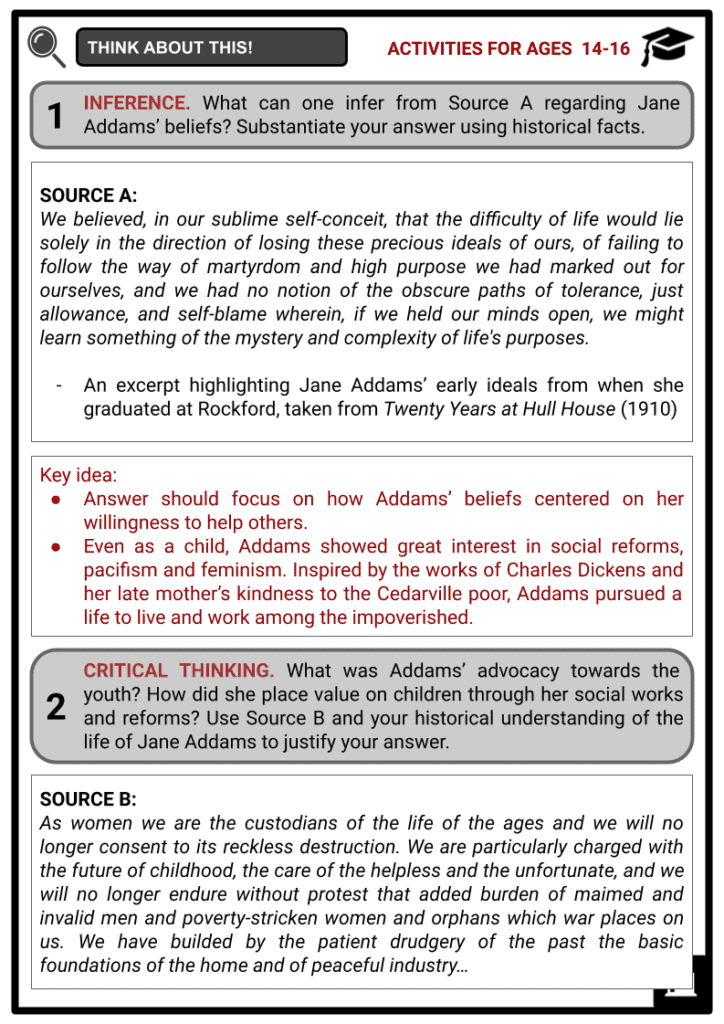Jane Addams Worksheets
Do you want to save dozens of hours in time? Get your evenings and weekends back? Be able to teach about Jane Addams to your students?
Our worksheet bundle includes a fact file and printable worksheets and student activities. Perfect for both the classroom and homeschooling!
Summary
- Early life of Jane Addams
- Chicago’s Hull House
- Other roles of Jane Addams
- Death and legacy
Key Facts And Information
Let’s find out more about Jane Addams!
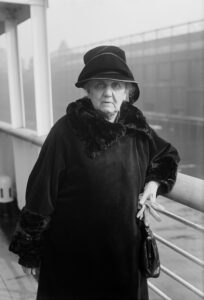
Laura Jane Addams was an American Progressive Era reformer, pacifist, peace advocate, social worker, and prolific writer best known for having co-founded the Hull House in Chicago, Illinois – one of the first settlements in the United States. Outside of her work as a prominent social reformer, she was also a committed pacifist and peace activist. She became the chair of the Women’s Peace Party, president of the Women’s International League for Peace and Freedom, and the first female president of the National Conference of Charities and Corrections. Her efforts and contributions to the community led her to win the 1931 Nobel Peace Prize.
EARLY LIFE
- Laura Jane Addams was born in Cedarville, Illinois, on 6 September 1860. She was the youngest of eight children born into an affluent family of English-American descent. She was cared for mostly by her older siblings after her mother died while being pregnant with her ninth child. Addams’ father remarried in 1868 to Anna Hosteler Haldeman.
- Addams adored her father, John H Addams, when she was a child. He was a founding member of the Illinois Republican Party and served as an Illinois State Senator from 1855 to 1870. He was also friends with Abraham Lincoln and thus supported him in his candidacies for senator and president.
- The relationship between John and his daughter was significant to Addams’ social works and contributions in the future as it gave her an opportunity to learn from an educated and worldly adult – something that was rarely experienced by many young women of this era.
- Even as a child, Addams showed great interest in social reforms. Inspired by the works of Charles Dickens and her late mother’s kindness to the Cedarville poor, Addams pursued a doctorate degree to live and work among the impoverished.
- Through her father’s request and encouragement, Addams pursued higher education at Rockford Female Seminary (present-day Rockford University). Her readings of Leo Tolstoy, Thomas Carlyle and John Ruskin became significant influences on her advocacies. Moreover, at Rockford, Addams learnt how valuable a supportive female community was.
- When John died in the summer of 1881 after a sudden case of appendicitis, Addams and her siblings inherited roughly $50,000, which was equivalent to $1.4 million in 2016. The death of her father placed her life in turmoil.
- Addams was able to complete her first year in medical school at the Woman’s Medical College of Pennsylvania but her spinal operation and nervous breakdown prevented her from completing the degree. Her failure brought her great sadness. However, she later realised that she did not have to become a doctor to be able to help the poor.
CHICAGO’S HULL HOUSE
- The 19th century saw a women’s movement to promote education and autonomy and break traditional male-dominated occupations for women. With this motive in mind, Jane Addams started showing interest in settlement houses – an institution that typically attracted educated, middle class and upper middle class women and men, known as ‘residents’, to live in poor urban neighbourhoods.
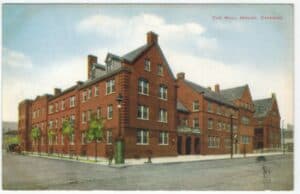
Huss House - Although struggling to find her place in the world, she travelled to London to visit Toynbee Hall – a settlement house that provided young men an opportunity to work to improve the lives of poor Londoners. Her experience there showed her the dream of having a neutral space where people could learn from each other. For Addams, the purpose of a settlement house was to reinvigorate one’s culture with the necessities of social reform by reconnecting with the diversity and conflict of the immigrant communities in America.
- Following the example of Toynbee Hall, in 1889 Addams and her friend Ellen Gates Starr co-founded the Hull House in Chicago – one of the first settlement houses in both the United States and North America. The run-down mansion was built in 1856 by Charles Hull. Although Addams willingly paid for any capital expenses needed to repair and upgrade the mansion, she was able to receive generous gifts from individuals who supported her settlement house.
- When the annual budget of the house grew rapidly, a number of wealthy women came forth and became long-term donors. This included Helen Culver, Mary Rozet Smith, Louise DeKoven Bowen and Mary Wilmarth.
- With Addams and Starr being co-founders, they also became the first two occupants of the house. By 1910, up to 70 people lived in the Hull House and more than 2,000 entered it a day. Hull House became a centre of research study and debate, and a pragmatic centre for living in and establishing good relations with the neighbourhood.
- The Hull House provided Addams with a supportive intellectual community and a basis for understanding urban life in the midst of a rapid immigrant influx. Its core residents were well-educated women committed to labour unions and the suffrage movement.
- It had a number of facilities that afforded an opportunity for young social workers to acquire training. Eventually, Hull House became a 13-building settlement complex that extended its services to include childcare, educational courses, a public kitchen, an art gallery, and several other social programmes.
- The Art Program of the Hull House was very important to Addams as it allowed her to challenge the system of industrialised education that categorised and fitted an individual into a specific job or position. She saw art as the key to unlocking the diversity of the city and disrupting fixed ideas to stimulate interaction based on a rewriting of cultural identities through interculturalism.
- The importance of art gave Addams the idea to open an art exhibition and studio space funded by Edward Butler. Facilities opened were a Butler Art Gallery and a branch of the Chicago Public Library. The art gallery featured works of local artists and recreations of famous artworks. The studio space within the gallery gave the community the opportunity to take art classes and hone their craft whenever they liked.
- The positive reaction of the children to the art classes in the house paved the way for Addams and Starr’s Chicago Public Art Society (CPSAS). The organisation provided public schools with reproductions of well-known pieces of art, took students on field trips to different art museums, and hired artists to teach children how to create art. The Hull House created deeper connections with people among the neighbourhood as it became an outlet of expression and exchange of different cultures.
- In 1963, with the construction of the University of Illinois’ Chicago campus, the Hull House was forced to move its headquarters, causing most of its buildings to be demolished. Despite this, the Hull House was transformed into a monument to honour Addams and Starr.
OTHER ROLES
- Outside of her work as a prominent social reformer, Jane Addams was also a committed pacifist and peace activist. In 1898, Addams joined the Anti-Imperialist League to oppose the US annexation of the Philippines. Being a devoted supporter of the Progressive Party, she nominated Theodore Roosevelt for presidency during the Party Convention in Chicago in 1912, and went on to campaign for him extensively in the presidential election.
- Addams also served on Chicago’s Board of Education in 1905. She would later on become the chairperson on the board’s School Management Committee. In 1910, Addams became the first female president of the National Conference of Charities and Connections (present-day National Conference of Social Work).
- Together with Lillian Wald, Addams wanted to create a United States Children’s Bureau to protect and take care of battered wives and children. They wanted the organisation to protest against child labour and demand decent care for children.
- She became involved in the Woman’s Peace Party and was elected national chairman in 1915. During the International Congress of Women in The Hague, Addams was invited to preside over European women peace activists and was chosen to head the commission to find an end to the war. This act was the first significant international effort against the war.
- In 1919 at a conference in Zurich, Switzerland, Addams continued the work of the Hague Congress as she was elected president of the International Committee of Women for a Permanent Peace. The committee later developed into the Women’s International League for Peace and Freedom (WILPF).
- Aside from her social work, pacifism and peace activism, she also authored and co-authored over 500 articles after she founded Hull House. With the articles appearing in scholarly periodicals, Addams became an established public philosopher, social leader and influential catalyst for change.
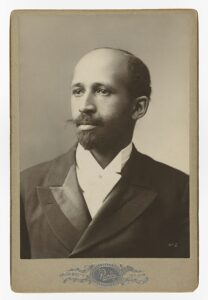
WEB DuBois - Some of the titles of the books she wrote were:
- Democracy and Social Ethics
- Children in American Street Trades
- New Ideals of Peace. Chautauqua
- The Wage-Earning Woman and the State
- Symposium: Child Labor on the Stage
- Twenty Years at Hull-House, with autobiographical notes
- Patriotism and Pacifists in War Time
- Peace and Bread in Time of War
- A New Conscience and an Ancient Evil
- She also worked with WEB DuBois, one of the well-known civil rights activists, to support African-American endeavours, and founded the National Association for the Advancement of Coloured People (NAACP).
- Addams became a member of the Fellowship of Reconciliation USA in 1917 and a member of the Fellowship Council until 1933. However, she wasn’t safe from criticism because when the US joined the war in 1917, harsh rebukes that criticised her as a pacifist were thrown at her. When she made a speech at Carnegie Hall, she received negative coverage by newspapers, which branded her as unpatriotic.
- Despite the criticism she received, in 1931 she became the first US woman to win the Nobel Peace Prize. She donated her prize money to the Women’s International League for Peace and Freedom.
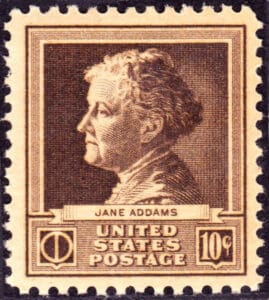
Stamp commemorating Addams
DEATH AND LEGACY
- From an early age, Addams was often troubled by health problems and, as she grew up, she began to suffer a more serious decline after a heart attack in 1926. Her deteriorating health led to her death on 21 May 1935, at the age of 74. Today, she is not only remembered for her social work, but also as one of the nation’s leading pacifists.
- The key pillar of Addams’ legacy was the Hull House. Her work life might have focused on the development of individuals, yet her ideas continue to influence social, political and economic reforms not just in the United States but also internationally. The Hull House, in particular, impacted communities and the whole social structure. Addams also reached out to colleges and universities in the hope of bettering the educational system, and passed on her knowledge to others through speeches and books.
Image Sources
- https://upload.wikimedia.org/wikipedia/commons/c/c4/Jane_Addams_-_Bain_News_Service.jpg
- https://upload.wikimedia.org/wikipedia/commons/thumb/a/a7/The_Hull_House%2C_Chicago_%28front%29.tif/lossy-page1-1200px-The_Hull_House%2C_Chicago_%28front%29.tif.jpg
- https://upload.wikimedia.org/wikipedia/commons/thumb/d/d3/W.E.B._Du_Bois_by_James_E._Purdy%2C_1907.jpg/623px-W.E.B._Du_Bois_by_James_E._Purdy%2C_1907.jpg
- https://upload.wikimedia.org/wikipedia/commons/3/35/Jane_Addams_1940_Issue-10c.jpg

